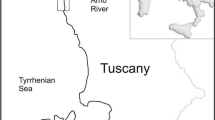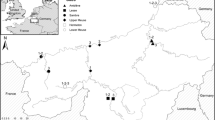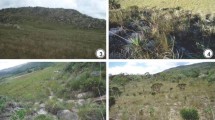Abstract
In coastal foredunes marram grass (Ammophila arenaria) is used to stabilize windblown sand. The development of traditionally plantedAmmophila into a more natural foredune vegetation may take 5 – 10 yr. For economic reasons, traditional planting may be replaced by alternative techniques such as planting seeds or disk-harrowing rhizome fragments. In this paper, we compare the initial vegetation development of traditionally planted stands with stands established from seeds and from rhizomes.
The experiments were conducted on an artificial foredune originating from dredged sea sand. The total experimental area covered more than 100 ha and the vegetation development was studied for 6 yr. The data were analysed bya priori grouping of plant species according to their ecology, as well as by Principal Components Analysis (PCA) and Redundancy Analysis (RA) of the percentage ground cover per plant species.
Comparing ecological groups of plants showed that all planting methods delivered equal numbers of plant species that are indicative for coastal dunes. PCA and RA showed that methods based on the use of rhizome material resulted in a higher percentage cover of clonal perennials (Calammophila baltica, Festuca rubra ssp.arenaria, Carex arenaria andCirsium arvense) than the traditionally planted stands and the stands obtained from seeds. The latter two were characterized by the dominance of annuals, bi-annuals and (mostly nonrhizomatous) perennials.
Initially, the rates of succession were highest in the stands obtained from rhizomes. However, after 3 – 6 yr there were no differences between the various stands. During the first four years, the percentage cover by rhizomatous foredune plants developed faster than that of annuals, bi-annuals and perennials. After 6 yr, the latter contributed almost as much to the percentage cover as the clonal species.
Similar content being viewed by others
References
Anon., 1989.Guide to the assessment of the safety of dunes as a sea defence. Report Technical Advisory Committee on Water Defence, Delft.
Adriani, M.J. & Terwindt, J.H.J. 1974.Sand stabilization and dune building. Rijkswaterstaat Communications no. 19.
Arens, S.M. & Wiersma, J. 1994. The Dutch foredunes; inventory and classification.J. Coast. Res. 10: 189–202.
Barr, D.A. & McKenzie, J.B. 1976. Dune stabilization in Queensland, Australia, using vegetation and mulches.Int. J. Biometeorol. 20: 1–8.
Brown, R.L. & Hafenrichter, A.L. 1948. Factors influencing the production and use of beachgrass and dunegrass clones for erosion control. II. Influence of density of planting.J. Am. Soc. Agron. 40: 603–609.
Hansen, K. & Vestergaard, P. 1986. Initial establishment of vegetation in a man-made coastal area in Denmark.Nord. J. Bot. 6: 479–495.
Hewett, D.G. 1970. The colonization of sand dunes after stabilization with marram grass (Ammophila arenaria).J. Ecol. 58: 653–668.
Hillen, R. & Roelse, P. 1995. Dynamic preservation of the coastline in the Netherlands.J. Coastal Conserv. 1: 17–28.
Hobbs, R.J., Gimingham, C.H. & Band, W.T. 1983. The effects of planting technique on the growth ofAmmophila arenaria (L.) Link andLeymus arenarius (L.) Hochst.J. Appl. Ecol. 20: 659–672.
Huiskes, A.H.L. 1977. The natural establishment ofAmmophila arenaria from seed.Oikos 29: 133–136.
Knutson, P.L. 1978. Planting guidelines for dune creation and stabilization. In:Coastal Zone. Proceedings of the Symposium on Technical, Environmental, Socioeconomic and Regulatory Aspects of Coastal Zone Management 1978. pp. 762–779. ASCE, San Francisco, CA.
Maun, M.A. 1994. Adaptations enhancing survival and establishment of seedlings on coastal dune systems.Vegetatio 111: 59–70.
Mennema, J., Quené-Boterenbrood, A.J. & Plate, C.L. 1980.Atlas of the Netherlands Flora. 1 Extinct and very rare species. Dr. W. Junk, The Hague.
Mitchell, A. 1974. Plants and techniques used for sand dune reclamation in Australia.Int. J. Biometeorology 18: 168–173.
Pilon, J.J. 1988. Kustafslag op Voorne in het verleden.Waterschapsbelangen 73: 255–259.
Rao, C.R. 1973.Linear statistical interference and its applications. 2nd. ed.. Wiley, New York, NY.
Rihan, J.R. & Gray, A.J. 1985. Ecology of the hybrid marram grass ×Calammophila baltica in Britain.Vegetatio 61: 203–208.
Sykes, M.T. & Wilson, J.B. 1988. An experimental investigation into the response of some New Zealand sand dune species to salt spray.Ann. Bot. 62: 159–166.
Sykes, M.T. & Wilson, J.B. 1990. An experimental investigation into the response of New Zealand sand dune species to different depths of burial by sand.Acta Bot. Neerl. 39: 171–181.
ter Braak, C.J.F. 1988.CANOCO — a FORTRAN program for canonical community ordination by [partial] [detrended] [canonical] correspondence analysis, principal components analysis and redundancy analysis (version 2.1). Groep Landbouwwiskunde, Wageningen.
Tsuriëll, D.E. 1974. Sand dune stabilization in Israel.Int. J. Biometeorology 18: 89–93.
van Bohemen, H.D. & Meesters, H.J.N. 1992. Ecological engineering and coastal defence. In: Carter, R.W.G., Curtis, T.G. & Sheehy-Skeffington, M.J. (eds.)Coastal dunes. geomorphology, ecology and management. Proceedings of the Third European Dune Congress, Galway/Ireland, pp. 369–378. A.A. Balkema, Rotterdam, Brookfield.
van der Laan, D. 1985. Changes in the flora and vegetation of the coastal dunes of Voorne (The Netherlands) in relation to environmental changes.Vegetatio 61: 87–95.
van der Maarel, E. 1979. Transformation of cover-abundance values in phytosociology and its effects on community similarity.Vegetatio 39: 97–114.
van der Meijden, R., Weeda, E.J., Holverda, W.J. & Hovenkamp, P.H. 1990.Heukels’ Flora van Nederland. Wolters-Noordhoff, Groningen.
van der Meijden, R., van Duuren, L., Weeda, E.J. & Plate, C.L. 1991. Standaardlijst van de Nederlandse Flora 1990.Gorteria 17: 75–127.
van der Putten, W.H. 1990. Establishment and management ofAmmophila arenaria (marram grass) on artificial coastal foredunes in The Netherlands. In: Davidson-Arnott, R. (ed.)Proceedings Canadian symposium on coastal sand dunes, pp. 367–387. Associate Committee on Shorelines, National Research Council and Guelph University, Guelph.
van der Putten, W.H. & Kloosterman, E.H. 1991. Large-scale establishment ofAmmophila arenaria and quantitative assessment by remote sensing.J. Coastal Res. 7: 1181–1194.
van der Putten, W.H. & Peters, B.A.M. 1995. Possibilities for the management of coastal foredunes with deteriorated stands ofAmmophila arenaria (marram grass).J. Coast. Conserv. 1: 29–39.
van Dieren, J.W. 1934.Organogene Dünenbildung: eine geomorphologische Analyse der Dünenlandschaft der West-Friesischen Insel Terschelling mit pflanzensoziologischen Methoden. Martinus Nijhoff, Den Haag.
Voogt, H. 1988. Verzwaring van de zeereep en problemen met helmbeplanting.Waterschapsbelangen 73: 208–213.
Westergaard, M. 1943. Cyto-taxonomical studies onCalamagrostis epigejos (L.) Roth,Ammophila arenaria (L.) Link, and their hybrids (Ammophila baltica (Fluegge) Link).Biol. Skr. 2: 1–68.
Westhoff, V. & van der Maarel, E. 1973. The Braun-Blanquet approach. In: Whittaker, R.H. (ed.)Ordination and classification of communities. Handbook of Vegetation Science. Part I. pp. 617–726. Junk, The Hague.
Author information
Authors and Affiliations
Additional information
Nomenclature: van der Meijden et al. (1990) for plant species. The plant species were classified into ecological groups according to van der Meijden et al. (1991) and Mennema et al. (1980).
Rights and permissions
About this article
Cite this article
van der Laan, D., van Tongeren, O.F.R., van der Putten, W.H. et al. Vegetation development in coastal foredunes in relation to methods of establishing marram grass (Ammophila arenaria). J Coast Conserv 3, 179–190 (1997). https://doi.org/10.1007/BF02905243
Received:
Revised:
Accepted:
Issue Date:
DOI: https://doi.org/10.1007/BF02905243




